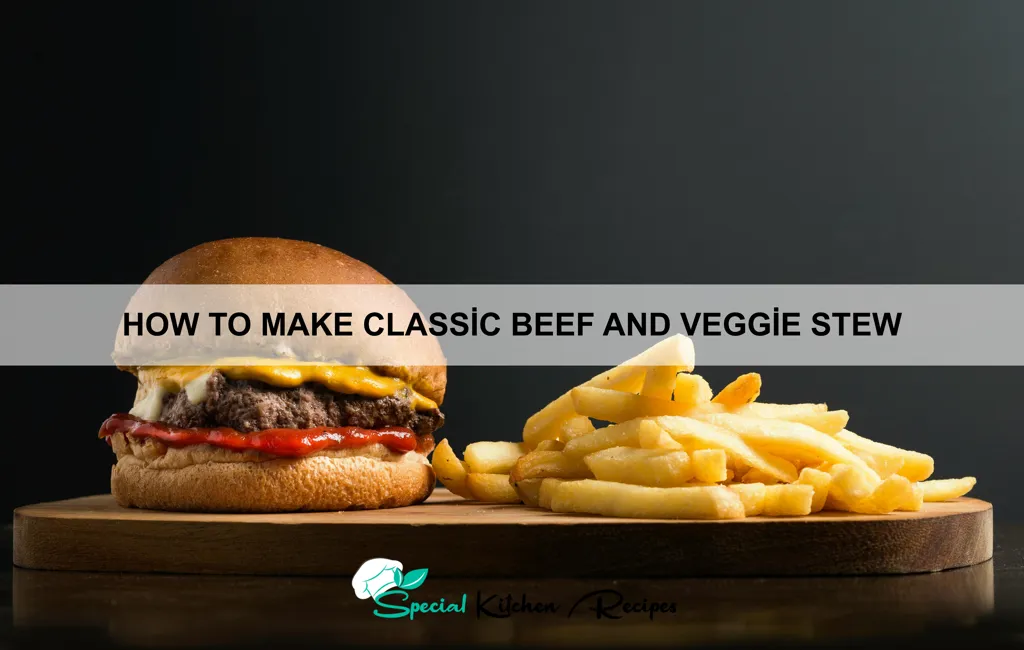Few dishes evoke the comforting warmth of home quite like a hearty beef stew. Its origins are shrouded in the mists of time, predating precise culinary records, but its evolution reflects the ingenuity of countless cooks across cultures and centuries. While pinpointing a single origin is impossible, evidence suggests variations of beef stew existed in ancient civilizations, utilizing readily available ingredients and simple cooking techniques over open fires. The Roman Empire, for example, is known to have enjoyed stews featuring beef and a variety of vegetables, reflecting the practicality of the dish for feeding large numbers of people.
The medieval period saw beef stew firmly established in European cuisines, particularly in colder climates where its ability to utilize tougher cuts of meat, rendered tender through long, slow cooking, was invaluable. The development of cast iron cookware played a significant role in its popularity, facilitating even heat distribution and the creation of that signature rich, deep flavor. This era also saw the incorporation of regional ingredients and spices, leading to the diverse range of beef stew recipes we see today – from the robust French Boeuf Bourguignon to the hearty Irish stew. The dish’s adaptability is key to its enduring appeal.
Beef stew’s cultural significance is undeniable, representing nourishment, community, and tradition. It’s a staple in many households worldwide, frequently appearing on family dinner tables during colder months. According to a recent survey by the National Restaurant Association, beef stew ranks consistently as one of the top ten most popular comfort food items in the United States, with an estimated 75% of adults reporting consuming it at least once annually. Beyond its place in the home, beef stew also holds a prominent position in pubs and restaurants, offering a comforting and familiar taste that transcends socioeconomic boundaries. This enduring legacy is a testament to its simple yet profound ability to satisfy both body and soul.
Ingredients and Measurements
This recipe yields approximately 6-8 servings of rich and flavorful classic beef stew. The success of your stew hinges on the quality of your ingredients, so don’t skimp! Choose a beef chuck roast for its excellent marbling and rich flavor, ensuring a tender and juicy final product.
Beef: 2 lbs beef chuck roast, cut into 1.5-inch cubes. Important: Ensure your beef is properly trimmed of excess fat, but don’t remove all of it. Some fat is essential for flavor and richness. Pat the beef cubes dry with paper towels before browning to ensure a good sear.
Aromatics: 2 large carrots, peeled and roughly chopped; 2 large celery stalks, roughly chopped; 1 large onion, roughly chopped. These form the base of your stew’s flavor profile. Recommendation: Use a combination of yellow and white onions for a more complex flavor. Rough chopping is sufficient as the vegetables will soften considerably during the long cooking process.
Liquid: 4 cups beef broth (low sodium preferred); 1 cup dry red wine (optional, but highly recommended for depth of flavor). Professional Tip: If omitting the wine, substitute with an additional cup of beef broth. Use a good quality beef broth for the best results. A homemade broth would elevate the stew to another level.
Flavor Boosters: 2 tbsp all-purpose flour; 2 tbsp tomato paste; 1 tbsp olive oil; 2 cloves garlic, minced; 1 tsp dried thyme; 1 tsp dried rosemary; 1 bay leaf; Salt and freshly ground black pepper to taste. Note: The flour helps to thicken the stew. Don’t be afraid to adjust the herbs to your preference. Fresh herbs, if available, will impart a more vibrant flavor.
Vegetables: 1 lb Yukon Gold potatoes, peeled and cubed; 1 cup frozen peas (added at the end for optimal texture). Important: Choose potatoes that hold their shape well during cooking. Yukon Golds are an excellent choice. Adding the peas at the end prevents them from becoming mushy.
Optional additions: 1/2 cup pearl onions; 1/2 cup mushrooms (cremini or button); 1-2 tbsp Worcestershire sauce. These additions can enhance the complexity and richness of your stew. Feel free to experiment with other vegetables and seasonings to personalize your recipe.
Measurement Summary: This ensures you have all the necessary ingredients before you begin. Always double-check your measurements for accuracy.
Preparation of Ingredients
Before you begin assembling your classic beef stew, meticulous preparation of the ingredients is key to achieving a rich and flavorful result. This stage sets the foundation for the entire dish, so take your time and pay attention to detail.
Start by preparing your beef. We’ll be using approximately 1.5 lbs of beef stew meat, cut into 1-inch cubes. Ensure the beef is relatively evenly sized to ensure even cooking. Larger pieces will be tougher, while smaller pieces may overcook and become dry. Pat the beef cubes dry with paper towels before browning; this helps achieve a better sear.
Next, prepare the vegetables. We’ll need 1 large onion, 2 carrots, and 2 celery stalks. Peel and roughly chop the onion into 1/2-inch pieces. Peel and chop the carrots into 1/2-inch thick rounds or diagonally cut pieces. Wash and chop the celery into 1/2-inch pieces, similar in size to the carrots and onions. Consistent sizing aids even cooking and prevents some vegetables from overcooking before others are tender.
For added depth of flavor, we’ll use 2 cloves of garlic, minced. Mincing ensures even distribution throughout the stew. You can also consider using a garlic press for a finer consistency. Don’t skip the garlic; it significantly contributes to the stew’s overall taste.
Now, let’s brown the beef. Heat 2 tablespoons of vegetable oil in a large, heavy-bottomed pot or Dutch oven over medium-high heat. Work in batches to avoid overcrowding the pot, which can lead to steaming instead of browning. Brown the beef cubes on all sides, ensuring a nice sear. This process develops a rich flavor and adds depth to the stew. Remove the browned beef from the pot and set it aside. Avoid overcrowding the pot, work in 2-3 batches if necessary to ensure proper browning.
Finally, prepare your aromatics. After browning the beef, reduce the heat to medium and add the chopped onions, carrots, and celery to the pot. Cook until softened, about 5-7 minutes, stirring occasionally. This process releases their natural sweetness and enhances the overall flavor profile of the stew. Add the minced garlic during the last minute of cooking to prevent burning. This step builds a flavorful base for your stew.
Sear the Beef
Searing the beef is a crucial step in developing deep, rich flavor in your classic beef stew. It’s not just about browning; it’s about creating a complex crust that contributes significantly to the overall taste. We’ll be working with approximately 2 lbs of beef stew meat, cut into 1.5-inch cubes. Ensure your beef is completely dry before searing; pat it down thoroughly with paper towels. Excess moisture will steam the beef instead of searing it, resulting in a less flavorful final product.
Season your beef generously with salt and freshly ground black pepper. A good rule of thumb is about 1 teaspoon of salt and ½ teaspoon of black pepper per pound of beef. Don’t be shy with the seasoning; the beef will absorb it during the searing process. You can also add other spices at this stage, such as garlic powder, onion powder, or paprika, to further enhance the flavor profile. However, remember that the stew itself will have its own seasoning later, so avoid overwhelming it here.
Heat a large, heavy-bottomed pot or Dutch oven over medium-high heat. A heavy pot is essential for even heat distribution, preventing hot spots that can burn the beef. Add about 2 tablespoons of high-smoke-point oil, such as canola or vegetable oil. Avoid using olive oil, as its lower smoke point makes it prone to burning at high temperatures. Once the oil is shimmering and hot, but not smoking, carefully add the beef cubes to the pot in a single layer, avoiding overcrowding. Overcrowding will lower the temperature of the oil, leading to steaming instead of searing.
Sear the beef in batches, ensuring each cube has ample contact with the hot surface. Brown the beef on all sides, taking about 3-4 minutes per side. This will create a beautiful, flavorful crust. Use tongs to carefully turn the beef, ensuring you don’t overcrowd the pot. Once all sides are nicely browned, remove the beef from the pot and set it aside. You can keep it on a plate or a clean baking sheet. Remember to work in batches to ensure proper browning; don’t try to sear all the beef at once.
Once all the beef is seared, you can proceed with the next step of your recipe. The browned beef bits left in the pot are crucial for flavor; don’t discard them! These fond bits will be the base for your delicious beef stew. They will add depth and richness to your final dish, so make sure you get a good sear on the beef to maximize their formation.
Building the Stew (Layering Vegetables and Liquids)
Now that your beef is beautifully browned, it’s time to build the flavor foundation of your stew. This involves carefully layering your vegetables and liquids to ensure even cooking and maximum flavor extraction. We’ll be using a classic combination, but feel free to adjust based on your preferences and available ingredients.
Begin by adding 1 large diced onion (about 1 cup) and 2 carrots, peeled and diced into 1/2-inch pieces (about 1 cup) to the pot. These will form the base of your flavor profile, providing sweetness and depth. Cook them for about 5 minutes, stirring occasionally, until they begin to soften. Don’t be afraid to let them lightly brown – this adds another layer of complexity.
Next, incorporate 2 celery stalks, finely diced (about 1/2 cup) and 2 cloves of garlic, minced. Cook for another 2-3 minutes until fragrant. The garlic shouldn’t brown, just release its aroma. This is a crucial step to build the savory foundation of the stew.
Now, it’s time for the liquid. We’ll use a combination of beef broth and red wine for richness and depth. Pour in 4 cups of beef broth and 1 cup of dry red wine (like Cabernet Sauvignon or Merlot). Using red wine significantly enhances the flavor, but if you prefer, you can substitute with an additional 1 cup of beef broth.
Scrape the bottom of the pot well to ensure you lift all those delicious browned bits from the beef – these are packed with flavor! Stir everything together to create a cohesive mixture.
Finally, add your potatoes and other root vegetables. We recommend using 2 pounds of potatoes, peeled and cut into 1-inch cubes. Other vegetables like 1 cup of peeled and diced parsnips or turnips can also be added at this stage. These starchy vegetables will break down slightly during the long cooking process, thickening the stew and adding a creamy texture. Avoid over-crowding the pot; this can hinder even cooking and result in soggy vegetables. If necessary, cook in batches.
Once all the vegetables are added, bring the stew to a gentle simmer, reduce the heat to low, cover, and allow it to cook slowly for at least 1.5-2 hours, or until the beef is incredibly tender and the vegetables are cooked through. The longer it simmers, the richer the flavor will become. Remember to stir occasionally to prevent sticking and to ensure even cooking.
Simmering and Cooking Time
The simmering process is crucial for developing the rich, deep flavor of a classic beef stew. It allows the tough beef cuts to become incredibly tender and allows the vegetables to soften and meld their flavors beautifully with the beef and broth. We recommend a minimum simmering time of 2-3 hours, but for the best results, aim for 3-4 hours, or even longer if you have a particularly tough cut of beef.
Once you’ve browned the beef and sautéed the vegetables, carefully transfer everything to your chosen cooking vessel – a large, heavy-bottomed pot or Dutch oven is ideal. Ensure the beef is fully submerged in the liquid; you may need to add more broth or water if necessary. Bring the mixture to a gentle simmer over medium heat. A gentle simmer means you should see only a few small bubbles breaking the surface; a rolling boil will toughen the meat and make the stew watery.
Once at a simmer, reduce the heat to its lowest setting, cover the pot with a tight-fitting lid, and let the magic happen! The lower the heat, the more tender the beef will become. This slow, gentle cooking process allows the collagen in the beef to break down, resulting in melt-in-your-mouth tenderness. Regularly check the stew throughout the cooking process to ensure it’s simmering gently and not drying out. If necessary, add a little more broth or water to maintain the desired liquid level.
For a richer, deeper flavor, consider adding a splash of red wine or Worcestershire sauce during the last hour of simmering. This will add a layer of complexity to your stew. Also, during the last 30 minutes of cooking, you can add any root vegetables that require less cooking time, such as carrots, parsnips, or turnips, to prevent them from becoming overly soft.
Remember, the longer you simmer the stew, the more tender the beef will become. However, be mindful not to overcook it, as it could become dry and fall apart. After 3-4 hours, check the beef for tenderness; it should be easily pierced with a fork. If it’s still a bit tough, continue simmering for another 30 minutes to an hour. Once the beef is perfectly tender and the vegetables are cooked through, remove the stew from the heat and let it rest for at least 15 minutes before serving. This allows the flavors to meld together even further.
Pro Tip: If you’re short on time, you can use a pressure cooker to significantly reduce the cooking time. However, keep in mind that the flavor might not be as rich and complex as with traditional simmering.
Thickening the Stew (if necessary)
While a classic beef stew should have a naturally rich and slightly thick gravy, sometimes you might find it needs a little extra body. This is especially true if you’ve used a lot of liquid or if you prefer a thicker consistency. There are several ways to thicken your stew, each with its own advantages and disadvantages.
The simplest method is to simmer the stew uncovered for a longer period. This allows excess liquid to evaporate, naturally concentrating the flavors and thickening the sauce. This process can take anywhere from 30 minutes to an hour, depending on your stovetop and the amount of liquid in your stew. Monitor the stew carefully to prevent burning; stir occasionally and reduce the heat if necessary.
For a more controlled thickening, a cornstarch slurry is highly effective. To make this, whisk together 2 tablespoons of cornstarch with 4 tablespoons of cold water in a small bowl until completely smooth. There should be no lumps. Slowly pour this slurry into the simmering stew, whisking constantly to prevent clumping. Continue to simmer for another 5-7 minutes, or until the stew reaches your desired thickness. Adding the slurry too quickly can result in a lumpy stew, so take your time.
Another excellent option is a roux. A roux is a mixture of equal parts fat (butter or oil) and flour. Melt 2 tablespoons of butter in a separate pan over medium heat. Whisk in 2 tablespoons of all-purpose flour and cook, stirring constantly, for 1-2 minutes, until the mixture is smooth and lightly golden brown. This step is crucial for developing flavor. Do not brown the roux too much, as it can impart a bitter taste. Gradually whisk the roux into the simmering stew, stirring continuously until the desired thickness is achieved. Simmer for a few more minutes to cook out the raw flour taste.
Finally, you can use a potato to thicken the stew naturally. If you haven’t already added potatoes, a couple of peeled and roughly chopped potatoes added during the final 30 minutes of cooking will release starch into the liquid, creating a naturally thickened stew. This method is less precise than using cornstarch or a roux, so it’s best suited for those who prefer a less controlled approach to thickening.
Remember to taste your stew after thickening and adjust seasoning as needed. Salt and pepper are often necessary to balance the flavors after adding a thickening agent.
Recommendations
For the richest, most flavorful beef stew, allow the stew to simmer for at least 2 hours, or even longer (up to 4 hours) for maximum tenderness. The longer it simmers, the more the flavors meld together. Don’t be afraid to experiment with different cuts of beef; chuck roast is classic, but other cuts like brisket or short ribs will also yield delicious results. Remember to brown the beef well before adding it to the pot; this step is crucial for developing deep, savory flavors.
Serving suggestions are plentiful! A classic pairing is crusty bread for dipping into the rich gravy. Consider serving your beef stew with fluffy mashed potatoes, creamy polenta, or buttery egg noodles. A side of steamed green beans or a simple salad adds a refreshing counterpoint to the hearty stew. For a more substantial meal, serve it with a side of roasted root vegetables like carrots, parsnips, and potatoes.
Storage is key to preserving the quality of your beef stew. Allow the stew to cool completely before storing it in airtight containers in the refrigerator. It will keep for up to 4 days. You can also freeze the stew for up to 3 months. To freeze, let it cool completely, then transfer it to freezer-safe containers, leaving some headspace to allow for expansion. When reheating, thaw overnight in the refrigerator and reheat gently on the stovetop or in the microwave.
Nutritional information (per serving, approximate values will vary based on ingredients and portion size): Calories: Approximately 400-500; Protein: 30-40g; Fat: 20-30g; Carbohydrates: 20-30g. These are estimates and will vary depending on the specific ingredients used and portion size. For a more precise nutritional breakdown, use a nutrition calculator with your exact ingredient list and quantities. Note: This recipe is rich in protein and iron, but may be high in saturated fat and sodium depending on the ingredients used. Adjust accordingly for dietary needs.
Complementary dishes to consider include a simple green salad with a vinaigrette dressing, crusty bread, and a glass of full-bodied red wine such as Cabernet Sauvignon or Merlot. The richness of the stew is beautifully balanced by the freshness of a simple salad, and the wine enhances the savory flavors. For a dessert, a light and fruity crumble or a scoop of vanilla ice cream would be a perfect ending to the meal.





